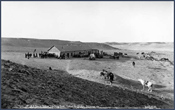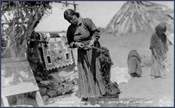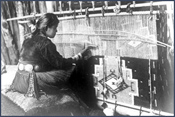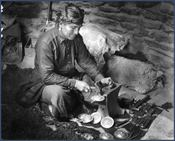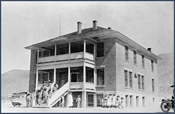Peoples of the Mesa Verde Region
The Historic Period: Late A.D. 1700s to Mid-1900sNavajo
The evidence for Navajo peoples in the Mesa Verde region during the early Historic period is relatively sparse. In general, the land north of the San Juan River was considered—not only by the Utes, but by other American Indians as well—to be Ute territory. Ute raiding drove most Navajos south of the San Juan River and out of the Mesa Verde region by 1750. In 1864, the U.S. Army rounded up more than 8,500 Navajos from west-central New Mexico and east-central Arizona and forcibly marched them to the Bosque Redondo Reservation in eastern New Mexico, on what is known as the "Long Walk." Some Navajos escaped the Long Walk by hiding out in remote areas, including a few places in the Mesa Verde region. 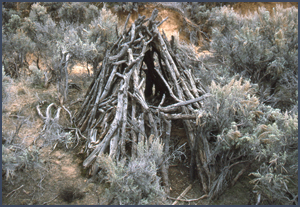
A Navajo forked-pole hogan from the late Historic period. (See enlarged photograph.) The Navajos were imprisoned at Bosque Redondo for four years. When they were finally released, they returned to a reservation that was reduced to 10 percent of the original Navajo homeland by a treaty signed in 1868. This treaty prohibited Navajo people from returning to most of the Mesa Verde region. Much of the population continued to live in traditional hogans throughout this period. The early Historic–period Navajo economy was based on sheep and goat herding, farming, weaving, and silversmithing. Beginning in 1868, traders (mostly people of European descent) came to the area and established trading posts, which quickly became economic and cultural-exchange centers, where Navajos would trade sheep, wool, rugs, baskets, and jewelry for products such as canned goods, tobacco, coffee, flour, sugar, and tools. The arrival of the railroads in the early 1880s provided the Navajo the opportunity to work for wages, and rail transport was a means to deliver Navajo arts and crafts to American markets. 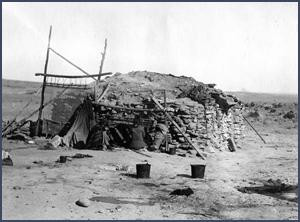
Circular masonry hogans and cribbed-log hogans became the predominant Navajo house type during the Historic period. Here, two women, one with a baby in a cradleboard, weave outside a masonry hogan. (See enlarged photograph.) The entry of the United States into World War II in 1941 changed Navajo life dramatically. More people began working for wages, and many joined various branches of the military. The Code Talkers were a group of approximately 400 Navajo Marines who developed a code based on the Navajo language. The code, which was used to transmit military messages, was never deciphered by the enemy, and the Code Talkers are credited with saving thousands of soldiers' lives. After World War II, mineral resources on the Navajo Reservation were extensively developed, and Navajos began working in uranium and coal mines, as well as in the oil and gas industries. About the hardships endured by the Navajo during the Long Walk. |
|
 DONATE TODAY
DONATE TODAY

